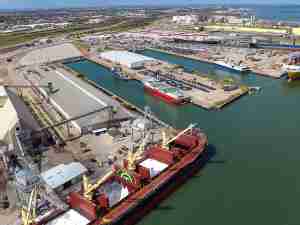The Memorandum of Agreement (MOA) between the two agencies was the first of its kind in South Carolina and is the state's longest-running collaboration on air quality within the public sector.
The new agreement continues work begun in 2007 to improve air quality in the area and expands the SCPA's commitments to evaluate and implement ways to minimize emissions at the port and across the tri-county region. The MOA took effect on March 31 and runs through the fall of 2018, with the opportunity to renew.
"This is a great example of interagency cooperation at the state level to support job creation and improve quality of life for our citizens," said Gov. Nikki Haley. "As we continue to streamline processes to help businesses grow in our state, this voluntary collaboration helps the environment without adding red tape."
"Our partnership with DHEC is an integral part of our overall environmental efforts, recognizing that a healthy, working port and a cleaner environment can be mutually compatible goals," said Jim Newsome, president and CEO of the SCPA. "The Port of Charleston today is known as a leader among ports in this region for environmental stewardship. We will continue to make environmental gains through efforts aligned with the competitiveness of our industry."
As part of the agreement, DHEC will provide technical assistance and expertise in support of the SCPA's operational improvements and environmental efforts.
"This agreement is above and beyond what the law requires," said DHEC Director Catherine Templeton. "This collaboration is a practical example of pursuing economic development while taking voluntary measures to reduce impacts and responsibly protect the environment."
The SCPA has committed in the MOA to a number of specific air quality measures, which include:
• Funding an ambient air monitoring station within the Charleston region that will measure air quality for a period of 23 months;
• Replacing retired equipment with cleaner equipment at all facilities;
• Designing the South Carolina Inland Port in Greer to accommodate electric gantry cranes for stacking containers;
• Continuing to use ultra-low sulfur diesel (ULSD) fuel in all port-owned equipment and evaluate the use of cleaner fuels and new technology that is commercially viable;
• Requiring clean construction contractor guidelines for Tier 2 or higher emissions standards for equipment as well as the use of ULSD; and
• Continuing periodic air emissions inventories to quantify port-wide air emissions.
The Port of Charleston was the first port in the region to commission a comprehensive air emissions inventory. The baseline inventory measured 2005 port-related air quality from the sea buoy to the county lines of Charleston, Berkeley and Dorchester counties - an area of roughly 2,500 square miles - and indicated that port-related emissions accounted for five percent or less of total pollutants in the area.
Subsequent inventories to measure 2011 and 2017 port-related air emissions will track the effect of the SCPA's truck replacement program and repower projects for cargo-handling equipment as well as new federal fuel standards for ocean-going vessels calling North American ports. The Environmental Protection Agency estimates that the Emissions Control Area (ECA) regulation will reduce ship-related air pollution by up to 85 percent.
Since 2007, the local maritime community has successfully received Diesel Emissions Reduction Act (DERA) and American Recovery and Reinvestment Act (ARRA) funding to help implement more than $5.5 million in various retrofits, upgrades and engine replacements to container-handling equipment, trucks, tugs and other marine equipment.
In addition, the MOA recognizes operational productivity, such

_-_28de80_-_939128c573a41e7660e286f3686f2a6e25686350_yes.jpg)








